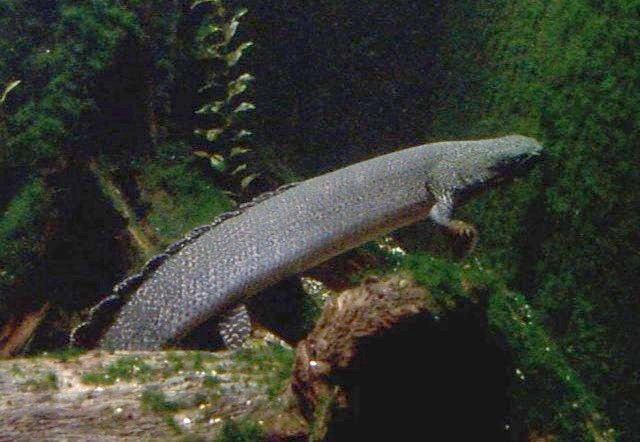 |
 |
| Name: Bichir |
| Scientific name: Polypterus ornatipinnis |
| Range: Central Africa and upper and central Zaire |
| Habitat: Hidden among the thickets of large water plants at the margins of rivers and lakes |
| Status: Not threatened |
| Diet in the wild: Earthworms and small fishes |
| Diet in the zoo: Chopped beef heart and fresh beef |
| Physical description:
The bichir is a decorated freshwater
fish that has an elongated body, little but wide head, circular tail, and
length about 2 ft long. The particular characteristic that we can
find in this fish is a sequence of finlets lengthwise in the back of the
bichir, that may be lifted or let down. Another characteristic is
the screened body with tough rhombic scales composed of the protein named
ganoin.
|
| Special anatomical, physiological or
behavioral adaptations:
This different fish at night goes out
of its natural habitat between the thickets of ample water plants at the
borders of rivers and lakes to feed. The bichir has lung-like swim-bladder
and gills to help breathing when it comes to the surface; nevertheless,
it does not bring any advantage because the bichir has to breathe again
in short time. Another physiological characteristic is a paired swim-bladder
which the two parts do not have the same size.
|
| Comments about the bichirs:
The bichir, because its primitive characteristics and
other unique characteristics, is well known in terms of anatomical and
evolutionary studies. The bichir has some features which make scientists
think about the difference between cartilaginous and bony fishes.
Some of these features are the bony skeleton where we find a high amount
of cartilage, the intestine that contains a spiral valve which is one of
the emblem of shark, and the spiracles as an extra gill behind each eye.
|
| Personal observations:
The bichir is a strange and old fish.
The bichir looks like a salamanders and has black bodies with bright speckles.
This fish normally does not fight with other fishes, and if you want to
put a bichir in a tank it will require numbers of hiding places, and a
depthless tank with approximately a foot of water. The bichir is
a really incredible fish that must be studied and protected for us.
|
| Sources materials and related links:
Ornate Bichir: Aquaria Central Buston Maurice and Robert. Encyclopedia of Fish. New York: Crow Publisher Inc., 1975. 32. Grzimek, Bernhard. Animal Life Encyclopedia.
Vol. 4. New York: Van Nostrand Reinhold Company, 1974. 132-143.
|
| Page author:
Eduardo Pereira Caldas
|